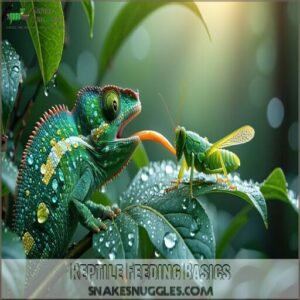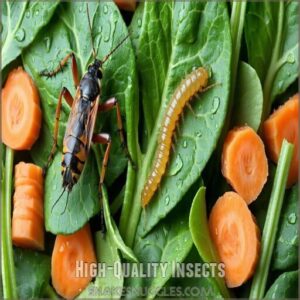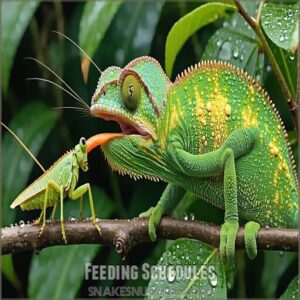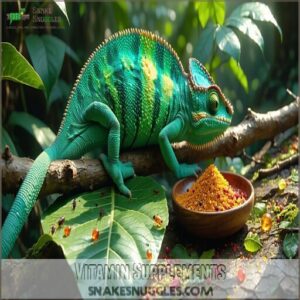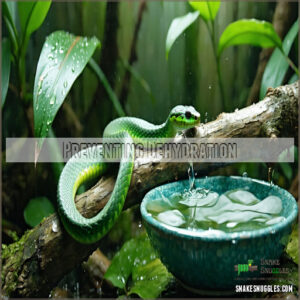This site is supported by our readers. We may earn a commission, at no cost to you, if you purchase through links.

Insectivores need crickets and mealworms with calcium supplements. Omnivores require a mix of insects, veggies, and fruits for digestive health.
Carnivores thrive on appropriately-sized live prey, while herbivores need fiber-rich leafy greens.
Choose high-quality insects from reputable sources, nutrient-rich fruits like berries, and greens such as kale and collard greens. Commercial foods can provide complete nutrition when needed.
Remember that proper feeding isn’t just about what you offer but when you offer it – the right schedule can make all the difference.
Table Of Contents
- Key Takeaways
- Reptile Feeding Basics
- Choosing Reptile Food
- Environmental Considerations
- Feeding Schedules
- Reptile Nutrition Tips
- Frequently Asked Questions (FAQs)
- What is the feeding plan for reptiles?
- What foods are toxic to reptiles?
- How often should you feed a reptile?
- What is the best feed for reptile?
- How to transition juvenile reptiles to adult diets?
- Can reptiles eat human food leftovers?
- Should reptiles fast before shedding?
- How to feed breeding/gravid female reptiles?
- Are wild-caught insects safe for reptiles?
- Conclusion
Key Takeaways
- You’ll need to choose the right food for your reptile based on its species, age, and size, and provide a balanced diet that includes insects, fruits, and veggies, with supplements to ensure they get all the necessary nutrients.
- It’s crucial to create a suitable environment for your reptile, including temperature gradients, UVB lighting, humidity levels, and water quality, to support their overall health and well-being.
- You should feed your reptile according to its species’ needs, with carnivores eating weekly, herbivores daily, and omnivores 2-3 times weekly, and portion sizes around 1-4% of their body weight.
- You’ll want to avoid giving your reptile human food leftovers, wild-caught insects, and toxic foods like avocado, chocolate, and citrus fruits, and instead opt for a nutrient-rich diet specifically formulated for reptiles to ensure they stay healthy and thrive.
Reptile Feeding Basics
You’re about to learn the basics of reptile feeding, and it’s necessary to understand that different species have unique dietary needs.
As you start your reptile-keeping journey, you’ll discover that providing the right food is critical for your pet’s health and well-being.
Insectivore Diet
You’ll feed insects to your reptile, like crickets or mealworms, as part of an insectivore diet, focusing on nutritional value and feeding frequency, considering gut loading and supplement needs for superior health.
A balanced reptile diet, incorporating appropriate supplements and gut-loading, is essential for their overall well-being.
Omnivore Diet
As an omnivore, your reptile needs a balanced diet.
Consider:
- Insect protein
- Vegetable protein
- Fruits and vegetables
- Proper ratios for digestive health, ensuring a balanced nutrition with food variety, like bearded dragons and box turtles, which thrive on omnivore diets.
Many reptiles are omnivorous and thrive on a mixed diet, which is essential for their overall health and digestive health.
Carnivore Diet
You’re exploring the carnivore diet, which typically includes live prey like rodents, insects, or fish.
Choose appropriate prey options, considering food size and feeding frequency.
Make sure safe handling and supplement needs, like calcium, are met for a balanced carnivore diet plan using feeder insects with high insect protein.
Herbivore Diet
As a reptile owner, you’ll focus on leafy greens for a herbivore diet.
Consider:
- Safe plants
- Plant variety
- Ample fiber
Herbivorous reptiles thrive on high-fiber diets, including a vegetable diet with leafy greens, avoiding toxins for a healthy reptile vegetable diet.
Choosing Reptile Food
You’re taking the first step in learning about reptile nutrition by choosing the right food for your pet.
When selecting reptile food, you’ll need to take into account options like high-quality insects, nutrient-rich fruits, leafy greens, and commercial foods to make sure your pet gets a balanced diet.
High-Quality Insects
You’ll need high-quality insects for your reptile, so choose reputable breeders, gut-load insects for nutritional value, and select the right ones, like crickets or roaches, to guarantee a balanced diet with proper insect selection and care for ideal feeder insect nutrition.
Many reptile owners purchase feeder insects for reptiles online for a balanced diet with proper care.
Nutrient-Rich Fruits
You’ll feed your reptile fruits like berries, melons, and figs.
Consider:
- Mango
- Papaya
- Berries for a nutrient-rich diet, adding them to your reptile food list for the best reptile food and ideal reptile nutrition with fruits and vegetables as nutrient-rich foods.
Proper reptile nutrition care tips are essential for maintaining their health.
Leafy Greens
You’ll find leafy greens like Kale, Collard Greens, and Mustard Greens perfect for herbivores.
| Greens | Nutrients |
|---|---|
| Kale | rich in vitamins |
| Collard Greens | high in fiber |
| Turnip Greens | packed with calcium |
Commercial Foods
Many commercial foods offer complete diets.
Finding the best reptile food online can simplify reptile care.
- Pelleted Foods
- Dry Mixes
- Gel Foods
- Frozen Options
Complete Diets for a safe reptile food choice in beginner reptile care, as outlined in this reptile food guide, focusing on reptile nutrition.
Environmental Considerations
You’re taking the right steps to learn about reptile care, and now it’s time to think about the environment your pet will be living in.
You’ll need to think about temperature gradients, UVB lighting, humidity levels, and water quality to create a healthy space for your reptile to thrive, considering all these factors to ensure a proper environment.
Temperature Gradients
Setting up reptile temperature gradients supports digestion and thermal regulation, impacting behavior.
Measure temperatures to create a suitable gradient, essential for beginner reptile care, in reptile habitats, ensuring proper temperature control for digestion support and overall health.
A key aspect of a detailed reptile guide is creating a suitable environment, which includes a temperature gradient, and this is essential for reptile habitats.
UVB Lighting
You’ll need UVB lighting to support vitamin D3 and calcium production, boosting reptile health and metabolism.
Choose the right UVB bulb type and placement to create a beneficial UVB gradient, essential for your pet’s overall well-being.
Humidity Levels
Proper lighting is key, but humidity is just as essential.
Ideal humidity keeps your reptile hydrated and healthy. Too little humidity can lead to dehydration and shedding problems. Too much can cause respiratory infections.
You’ll need a humidity gauge. Here’s the deal with humidity:
- Monitor humidity with a hygrometer.
- Adjust humidity based on your reptile’s species requirements.
- A misting system can help maintain humidity.
- Watch for signs of dehydration, like sunken eyes.
Water Quality
You make sure your reptile’s water is clean by doing regular water changes, removing chlorine, and using filtration.
Monitor water temperature to prevent dehydration, providing fresh water for hydration, and maintaining good water quality is key to your reptile’s health.
So, change the water often to ensure good water quality.
Feeding Schedules
You’re learning about feeding schedules for your reptile, and it’s great that you’re taking the time to understand their needs.
By following a proper feeding schedule, you’ll be able to provide your reptile with the nutrients it needs to thrive, and you’ll learn how to adjust the frequency and portion sizes as it grows.
Frequency of Feeding
You’ll determine your reptile’s feeding schedule based on age, activity levels, and weight monitoring.
Adjust the feeding frequency as your pet grows, considering its life stage and individual needs, to create a suitable feeding schedule for your reptile.
Following a beginner reptile guide for ideal reptile feeding practices is essential to ensure the health and well-being of your pet.
Portion Sizes
When considering portion sizes, your reptile’s body weight percentage guides the way.
Feed young reptiles 3-4% of their weight daily, while adults need just 1-2%.
For snakes, a helpful snake feeding schedule chart clarifies appropriate prey sizes.
For a quick visual guide: food items shouldn’t be wider than the space between your lizard’s eyes.
For snakes, prey size should stay smaller than the widest part of their body to prevent feeding issues.
Gut-Loading Insects
Your insect feeders’ nutrition directly impacts your reptile’s health.
Before feeding crickets, roaches, or other feeder insects to your pet, boost their nutritional value through gut loading.
Feed them vitamin-rich vegetables and fruits for 24-48 hours before serving.
This process enriches the insects with essential nutrients, enhancing your reptile’s vitamin absorption and gut health.
It’s like creating a nutritious meal within a meal!
Rotating Food Sources
Just like you wouldn’t want to eat the same meal every day, your reptile needs variety too.
Rotating food sources helps prevent nutritional gaps and keeps mealtime interesting.
Mix up protein sources by alternating between gutloaded crickets, mealworms, and roaches.
For herbivorous species, switch between different dark leafy greens and vegetables weekly.
This natural approach mimics wild feeding patterns and reduces the risk of deficiencies.
Reptile Nutrition Tips
You’ll need more than just basic foods to keep your pet reptile healthy and strong, so it’s important to understand supplements and proper nutrition.
Your scaly friend’s growth, energy, and long-term health depend on getting the right balance of calcium, vitamins, and other nutrients in their daily meals.
Calcium Supplements
Proper calcium supplementation stands between your reptile and metabolic bone disease. Your scaly friend needs the right calcium-to-phosphorus ratio to thrive.
Reptile owners can purchase calcium powder online.
Here are key calcium sources and guidelines:
- Dust feeder insects with calcium powder before every feeding
- Choose supplements without added phosphorus
- Provide cuttlebone for voluntary calcium intake
- Monitor UVB exposure for ideal absorption
- Watch for signs of deficiency like tremors or soft jaw
Vitamin Supplements
In addition to calcium, your reptile needs vitamin supplements for best health.
Proper reptile nutrition care tips are essential for maintaining their well-being.
Vitamin D3 helps calcium absorption, while vitamin A supports vision and skin health.
Multivitamins fill nutritional gaps in your reptile’s diet.
| Supplement Type | Frequency | Benefits |
|---|---|---|
| Vitamin D3 | 2-3x weekly | Calcium absorption, bone health |
| Vitamin A | 1x weekly | Vision, skin, immune function |
| Multivitamin | 1-2x weekly | Overall nutritional support |
| Carotenoids | 2x monthly | Natural vitamin A source |
Don’t overdo it – excess vitamins can harm your pet just like deficiencies can, so it’s crucial to follow a balanced reptile nutrition plan.
Preventing Dehydration
Your reptiles can quickly become dehydrated without proper water access.
Keep them healthy with these hydration essentials:
- Place shallow water dishes in accessible locations
- Mist enclosures daily for humidity-loving species
- Monitor substrate moisture levels (30-70% depending on species)
- Offer weekly soaking opportunities (5-15 minutes)
- Check humidity levels twice daily with a reliable gauge
Fresh water changes prevent bacterial growth while supporting proper digestion and shedding.
Recognizing Nutritional Deficiencies
Keeping your reptile hydrated goes hand-in-hand with watching for nutritional deficiencies.
You’ll want to look for warning signs like lethargy, muscle tremors, or unexplained fractures – classic indicators of Metabolic Bone Disease.
If your pet shows appetite changes, swollen eyelids, or strange skin/shell problems, they may have vitamin deficiencies.
Quick action prevents malnutrition from becoming serious, so document any concerning changes and consult your vet promptly to address potential nutritional deficiencies.
Frequently Asked Questions (FAQs)
What is the feeding plan for reptiles?
Like a well-oiled machine, your reptile’s feeding plan varies by species. You’ll feed carnivores weekly, herbivores daily, and omnivores 2-3 times weekly with appropriate supplements and gut-loaded insects.
What foods are toxic to reptiles?
Avoid feeding your reptile avocado, chocolate, onions, garlic, citrus fruits, grapes, and raisins. These foods can be toxic and harm your pet’s health.
How often should you feed a reptile?
You’ll feed your reptile 3-4 times a week, depending on age, size, and species, with portion sizes around 1-4% of their body weight.
What is the best feed for reptile?
You’ll want a balanced diet for your reptile, including insects, fruits, and veggies, with supplements to make sure they get all the necessary nutrients for best health and growth.
How to transition juvenile reptiles to adult diets?
Variety is key when shifting juvenile reptiles to adult diets.
You’ll gradually introduce new foods, increasing portion sizes and nutrient diversity to make sure a smooth, healthy shift, every few weeks.
Can reptiles eat human food leftovers?
You shouldn’t give reptiles human food leftovers, as they can be toxic or cause nutritional imbalances, so it’s best to stick to a balanced, nutrient-rich diet specifically formulated for reptiles.
Should reptiles fast before shedding?
You shouldn’t fast your reptile before shedding, as it can cause stress and nutrient deficiencies, potentially leading to health issues during this critical period.
How to feed breeding/gravid female reptiles?
You’ll need to boost their diet with extra calcium and protein to support egg development, ensuring a healthy reproductive cycle for your breeding female reptiles.
Are wild-caught insects safe for reptiles?
You should avoid wild-caught insects, as they may carry pesticides, parasites, or diseases, posing health risks to your reptiles, so opt for captive-bred or gut-loaded insects instead.
Conclusion
What’s next for you as a reptile owner?
You’re now equipped with a solid reptile food guide for beginners, so go ahead, give your pet the best.
Remember, a balanced diet is key, and with this reptile food guide for beginners, you’ll be well on your way to raising a happy, healthy reptile, it’s that simple.
- https://vetericyn.com/blog/reptile-care-for-beginners-a-helpful-guide/
- https://www.zillarules.com/articles/what-do-i-feed-my-reptile-to-keep-it-healthy
- https://www.wagstowiskers.com/pupdates/2020/10/30/beginners-guide-to-caring-for-reptiles
- https://hikariusa.com/wp/reptiles-beginners-hikari-food-eat-2/
- https://talis-us.com/blogs/news/the-easiest-reptile-to-take-care-of-a-guide-for-beginner-pet-owners

